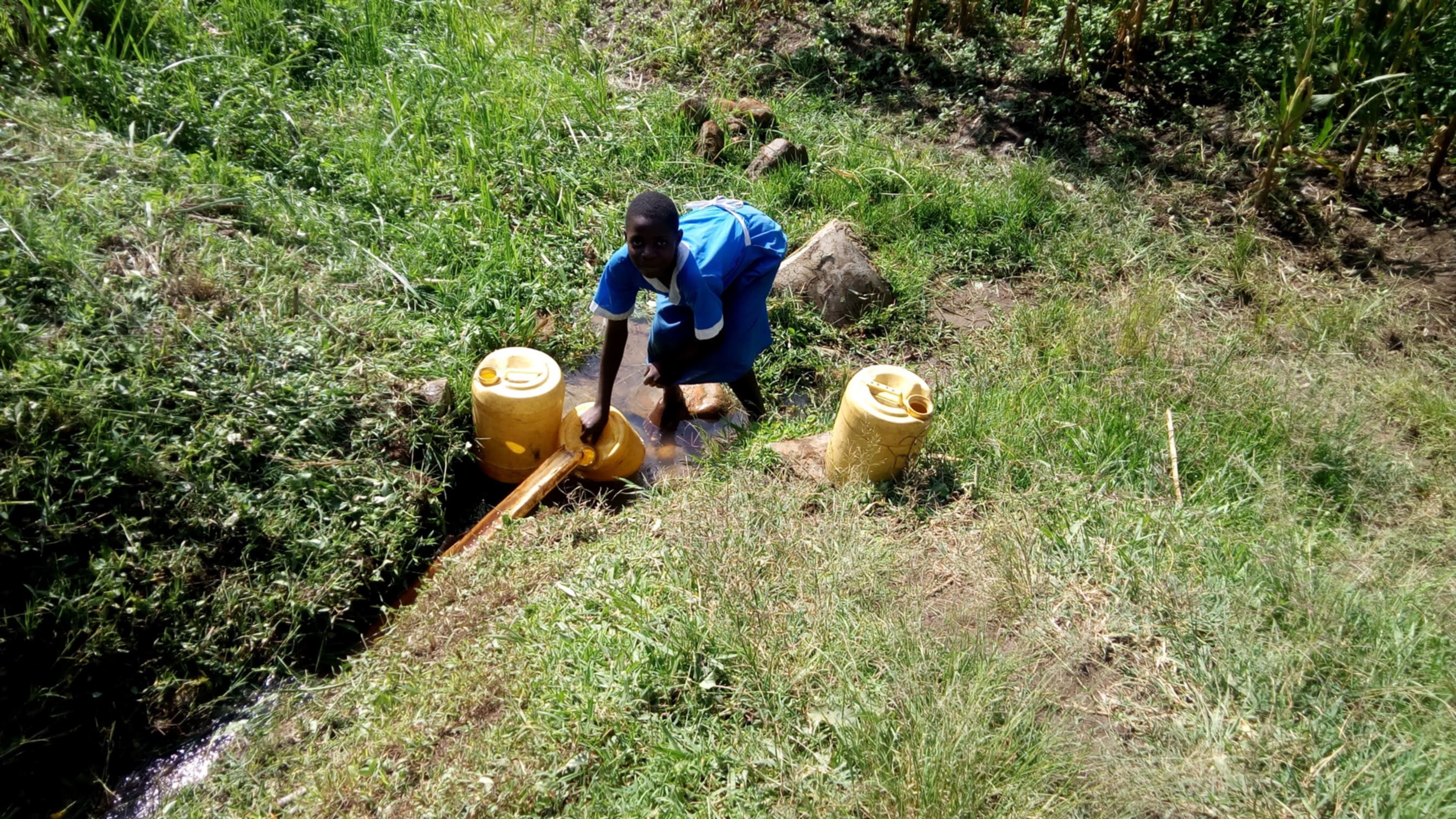This project is a part of our shared program with Western Water and Sanitation Forum (WEWASAFO). Our team is pleased to directly share the below report (edited for clarity, as needed).
Welcome to the Community
Shivagala Community is home to farmers who plant sugarcane and maize plantations. They wake up very early during the rainy months to work on their farms. In the dry seasons, the farmers take their harvests to sell at the market. Other crops that yield good income are beans, rice, millet, sesame, and bananas. Those are all grown here because the land is fertile.
Water Situation
Paul Chengoli Spring is named after its landowner. It is one of the main sources of water in Shivagala Community, though it is contaminated. It is especially dirty during the rainy season, as more dirt, waste, and farming chemicals are washed into the water.
Locals have fixed a banana tree stalk to help funnel the water into their containers. Most of these don't have lids anymore, since kids take them to play with as toys.
While 205 people regularly use Paul Chengoli Spring throughout the year, there are even more users during the dry season. Even when it doesn't rain, this water source continues flowing. Its water is used for cooking, cleaning, and drinking. After consuming this water, people suffer from typhoid. The diarrhea is especially difficult for small children and the elderly.
Sanitation Situation
Households here have pit latrines, but they are made of mud walls and wooden floors. People just aren't cleaning them for fear that the wood slats will rot away (for good reason!). There are many dish racks and clotheslines, but no hand-washing stations. Mr. Paul Chengoli himself has asked for intense training on the importance of hand-washing, and he'd like to learn how to build a hand-washing station.
Malaria is also an issue here because families haven't cleared the brush around their compounds. The spring also has a lot of stagnant water around it. Mr. Chengoli said, "There is a nearby river in which the spring drains into and it is a breeding ground for mosquitoes. Cases of malaria outbreak are rampant in the community."
Plans: Hygiene and Sanitation Training
Community members will attend hygiene and sanitation training for at least two days. This training will ensure participants are no longer ignorant about healthy practices and their importance. The facilitator plans to use PHAST (Participatory Hygiene and Sanitation Transformation), CLTS (Community-Led Total Sanitation), ABCD (Asset-Based Community Development), group discussions, handouts, and demonstrations at the spring. One of the most important topics we plan to cover is open defecation and its dangers, as well as having and using a pit latrine.
Training will also result in the formation of a committee that will oversee operations and maintenance at the spring. They will enforce proper behavior around the spring and delegate tasks that will help preserve the site, such as building a fence and digging proper drainage. The fence will keep out destructive animals, and the drainage will keep the area’s mosquito population at a minimum.
Plans: Sanitation Platforms
On the final day of training, participants will select five families that should benefit from new latrine floors.
Training will also inform the community and selected families on what they need to contribute to make this project a success. They must mobilize locally available materials, such as bricks, clean sand, hardcore, and ballast. The five families chosen for sanitation platforms must prepare by sinking a pit for the sanitation platforms to be placed over. All community members must work together to make sure that accommodations and food are always provided for the work teams.
Plans: Spring Protection
Fetching water is predominantly a female role, done by both women and young girls. Protecting the spring and offering training and support will therefore help empower the female members of the community by giving them more time and efforts to engage and invest in income-generating activities.
In addition, protecting the spring will ensure that the water is safe, adequate and secure. Construction will keep surface runoff and other contaminants out of the water.
As soon as Shivagala Community heard about this opportunity, they started collecting sand and stones for our artisan to use in construction of the spring protection. Paul Chengoli Spring is a permanent and high-yielding source of water for Shivagala Community. It serves a vast area, especially during the dry seasons when all the other springs dry up. People come from very far and carry water using motorcycles. When interviewing Mr. Paul, he could not hide his disappointment as he explained to us how he had tried all he could to get the spring protected by the ward administrator. The protocol of getting help from the county government to protect the spring had been tiresome and futile for Shivagala, and they're more than ready for help!

 Protected Spring
Protected Spring
 Rehabilitation Project
Rehabilitation Project
































